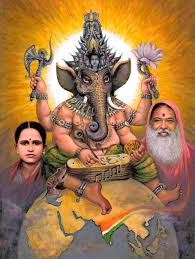Mahorasko maheṣvāso gūḍhajatru rarindamaḥ
ājānubāhu ssuśirāh sulalāṭa ssuvikramaḥ
Meaning- Rama has a broad and strong chest. He carries with Him a strong, supreme and splendid bow. His collarbones, that are very strong, are not visible (finely covered). He overcomes enemies easily. His hands are long enough to touch his knees. His head as well as his forehead are sturdy, beautiful and proportionate. His possesses great valour (parakrama).
There are many hymns which proclaim that the Supreme Lord who has no form, no shape, no weapon and no fixed place of residence takes on a form and shape solely for the convenience of his devotees. This same statement is re-affirmed by our Upanishads.
For our convenience, Maharishi Narada is describing the bodily features of Rāma, who is none other than the Supreme Almighty!
Mahoraskah- Rama has a massive, broad, rigid, tough, prominent and upright chest. The Sāmudrika Shastra (a scripture that interprets the features of the body and foretells the future based on that) states that a person with these physical features will become a king. In the case of Rama, He was not only a king for this visible world, but in addition he was also the emperor of the inner kingdom called Self (atma samrajyam).
Maheṣvasah- His body is so well-built and firm that he can support the most powerful bow. The bow that Rama wears on his body is no average one; it is the mighty Kodanda. Even to hold it casually, one should necessarily possess a extremely powerful body. More importantly, the person should the energy required to hold it.
The bow that Rama broke at the time of His marriage belonged to Shiva (Shiva dhanus). All of us know that Lord Shiva retains the mighty, forceful and gigantic River Ganga on His head. How powerful and mighty should the bow of this Lord, who has the capacity to retain a massive river on His head, be? It is beyond imagination.
Moreover, Shiva has a celestial body while Rama had a human body. If with the human body, Rama broke Shiva’s bow, then it was a feat that was accomplished purely due to the power of His inner Self. In another instance, He calmly and easily took over the Vaishnava bow from Parashurama. Both these instances teach us the oneness between Shiva and Vishnu principles that exists within Rama.
Goodha jatruh- Gudhajatru is one whose collarbones (jatru) are not visible due to the fleshy muscular chest. According to the Sāmudrika shastra the person in whom the collarbones are imbalanced or are very minute (sookshma) will face great deprivation (daridra) in life. When they are even and balanced, the person will enjoy all luxuries in life (bhogi). Where these collarbones are deep, the person will be poor. Where the person has tough and strong collarbones, as in the case of Rama, the person will be a king.
Arindamah- He who subjugates his enemies is arindamah. In the earlier hymn a similar term ‘shatru nibarhanah’ was used. What could be the purpose behind this repetition? The term ‘enemies’ (shatru) includes both the inner as well as external enemies of a person. The term ‘ari’ in this word ‘arindamah’ instantly brings to memory the ‘arishadvargas’. (Arishadvargas are the 6 internal enemies of a person such as kaama (desire), krodha (anger), lobha (greed), moha (infatuation), mada (pride) and matsarya (jealousy)). This word in turn helps us recollect Yoga. Rama has conquered all his arishadvargas and He helps those, who have placed implicit faith in Him, to reach the similar state.
Ajaanubaahuh – Rama has long arms that reach up to His knees. Hence He is addressed as Ajaanubaahu. Samudrika shastra declares that such a person will be a sarvabhouma (universal monarch of the highest degree).
Susirah- His head will be round and even in shape. Our scriptures state that He who has a uniform and even head that is round in shape with the head that is in the shape of an umbrella, will have long life and be an absolute monarch of the land. This proved to be true in the case of Rama.
Sulalaata- The beauty of His forehead is beyond every form of comparison. It is as beautiful as the crescent moon.
Suvikramah- His gait is beautiful. Noiselessly He releases the arrow from His bow. When he enters the field and wrestles, the dust does not rise even by a fraction. Even in the midst of a terrible war, the smile on His face never fades. Without even the subtlest change, He accomplishes the greatest feats with ease. Hence, He is addressed as Suvikramaha.
His gait is far more superior than the elephant’s or lion’s gait. So noiselessly He walks. Even walking very swiftly does not tire him in the least. Hasn’t the graceful and delicate gait of a woman been compared to that of a swan (hamsa)? This is beautifully expressed in Lalita Sahasranama in the verse- maraali mandagamana mahaa laavanya sevadhih. Rama’s walk is profound and deep (gaambhirya). Hence He is – mahaa gaambhirya sevadhih.
